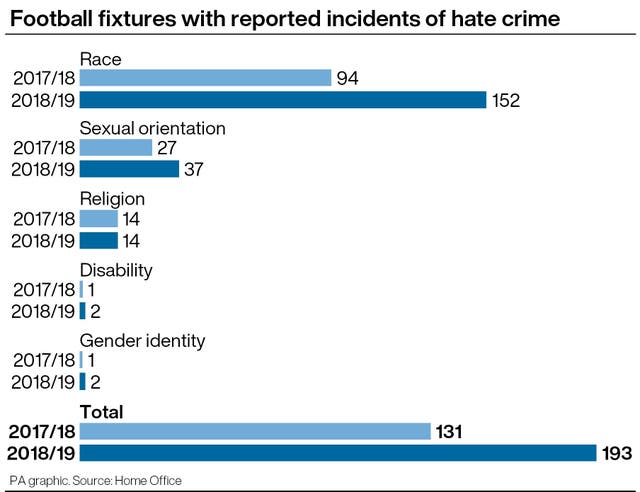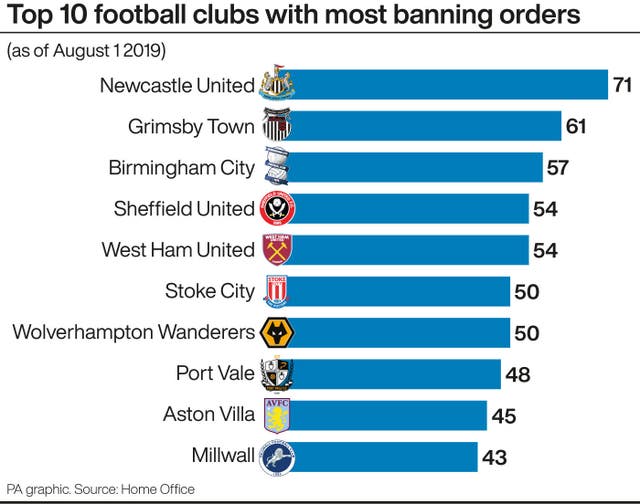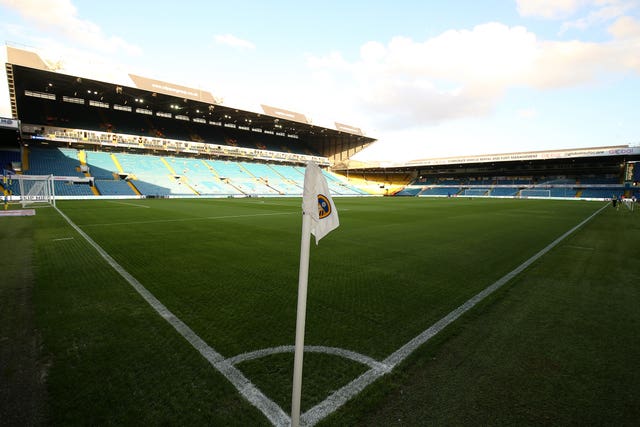Hate crime reports at football matches rose by almost 50 per cent during the 2018-19 season compared to the previous campaign.
Data released by the Home Office on Thursday stated that incidents of hate crime were reported at 193 matches between August 1, 2018 and July 31, 2019, a 47 per cent rise compared to 131 matches the year before.
The Home Office report said that of those hate crime incidents, 79 per cent related to race. It stated that the increase may be due to improvements in recording the data.

The number of arrests for racist and indecent chanting fell from 15 in 2017-18 to 14 in 2018-19.
However, it is twice as many as the number of arrests for the same offence in 2016-17 – just seven.
The figures also showed that the number of new football banning orders issued during the 2018-19 season rose by 19 per cent compared to the previous year.
Just under a third (31 per cent) of the total banning orders in force at August 1, 2019 were issued during the 2018-19 campaign, covering the period August 1, 2018 to July 31, 2019.
Supporters of Sky Bet Championship club Stoke were issued the highest number of new banning orders during that time – 46.

Their Staffordshire neighbours Port Vale in League Two were second on the list with 31.
Supporters of Premier League club Newcastle have the most banning orders in force overall at 71, eight fewer than in the previous season.
There were 1,771 football banning orders in force on August 1, 2019, a decrease of three per cent compared to the same date in 2018, when 1,822 were in force.
The duration of a banning order, which are used to bar individuals from attending matches and in some cases can require them to surrender their passports ahead of overseas fixtures, can range from a minimum of three years up to a maximum of 10 years.

The data also showed that football-related arrests had dropped by 10 per cent in 2018-19 compared to the previous season.
There were 1,381 football-related arrests in England and Wales in the 2018-19 season.
The clubs with the highest number of arrests were Stoke (80), Leeds (49) and Aston Villa (42) according to the data.
Stoke said in a statement released to the PA news agency: “The latest Home Office statistics do not make for pleasant reading but to provide some context 62 of the 80 arrests were as a result of anti-social behaviour that occurred both during and after the Checkatrade Trophy fixture against Port Vale in December 2018.
“Of the other 18 arrests, only five of those were made at home fixtures at the bet365 Stadium where, working in partnership with the police and authorities, we are continuing to do everything we can to try and eradicate anti-social behaviour from football.”
Deputy Chief Constable Mark Roberts, the National Police Chief’s Council football policing lead, said: “Home Office statistics show football disorder remains at concerning levels – over the past two seasons, incidents reported are at more than 1,000 fixtures, and worryingly, this is becoming the new normality.
“Interestingly, higher levels of disorder are being seen in the lower leagues, and this could be attributed to the fact there is often a reduced police presence.
“With the absence of police officers to witness and respond, we are reliant on supporters and other agencies to report matters to us, so there could be a lot that goes unreported. There is also a reluctance from the leagues to share safety officer’s reports with us at a national level.

“Notably there are a greater number of arrests made in the lower leagues, despite lower crowds, with four out of the five clubs with the most arrests from the Championship. This is also reflected in the fact that Grimsby Town, a League Two club, has the second-highest number of (overall) banning orders, rising from 50 to 61 over the past two seasons.
“A lower number of arrests in the Premier League is likely related to the fact these clubs have greater security measures in place, and a police presence at matches.
“Hate crime is also on the rise, and this reflects some of the high profile incidents reported over the past season. The 28 per cent increase in arrests by British Transport Police, shows the levels of disorder away from the stadiums.
“We are committed to working with the leagues and clubs to tackle these issues but that will take a sustained focus on security from all concerned.”
Of the 1,381 arrests under Schedule 1 of the Football Spectators Act 1989, the most common types of offence were public disorder (38 per cent) and violent disorder (19 per cent).
We carry out unannounced patrols in stations and on trains nationwide. This is part of our plan to disrupt, detect and deter criminal activity on the railway. We are here to keep you safe.#FocusedOnYourSafety | #WeAreBTP pic.twitter.com/U9Yas27P86 — British Transport Police (@BTP) August 18, 2019
A further 155 were made by British Transport Police and there were 347 ‘other’ arrests at football matches which did not fall under Schedule 1 of the Football Spectators Act.
The statistics are supplied by the 43 police forces in England and Wales and British Transport Police (BTP) to the United Kingdom Football Policing Unit (UKFPU).
Supporters of Premier League sides Sheffield United (41), Manchester City (39) and Manchester United (36) were fourth, fifth and sixth respectively in the football-related arrests statistics for 2018-19.







